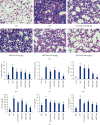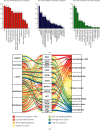Anti-Inflammatory Mechanisms of Total Flavonoids from Mosla scabra against Influenza A Virus-Induced Pneumonia by Integrating Network Pharmacology and Experimental Verification
- PMID: 35722153
- PMCID: PMC9200497
- DOI: 10.1155/2022/2154485
Anti-Inflammatory Mechanisms of Total Flavonoids from Mosla scabra against Influenza A Virus-Induced Pneumonia by Integrating Network Pharmacology and Experimental Verification
Abstract
Influenza virus is one of the most common infectious pathogens that could cause high morbidity and mortality in humans. However, the occurrence of drug resistance and serious complications extremely complicated the clinic therapy. Mosla scabra is a natural medicinal plant used for treating various lung and gastrointestinal diseases, including viral infection, cough, chronic obstructive pulmonary disease, acute gastroenteritis, and diarrhoea. But the therapeutic effects of this herbal medicine had not been expounded clearly. In this study, a network pharmacology approach was employed to investigate the protective mechanism of total flavonoids from M. scabra (MSTF) against influenza A virus- (IAV-) induced acute lung damage and inflammation. The active compounds of MSTF were analyzed by LC-MS/MS and then evaluated according to their oral bioavailability and drug-likeness index. The potential targets of each active compound in MSTF were identified by using PharmMapper Server, whereas the potential genes involved in IAV infection were obtained from GeneGards. The results showed that luteoloside, apigenin, kaempherol, luteolin, mosloflavone I, and mosloflavone II were the main bioactive compounds found in MSTF. Primarily, 23 genes were identified as the targets of those five active compounds, which contributed to the inactivation of chemical carcinogenesis ROS, lipid and atherosclerosis, MAPK signaling pathway, pathways in cancer, PI3K-AKT signaling pathway, proteoglycans in cancer, and viral carcinogenesis. Finally, the animal experiments validated that MSTF improved IAV-induced acute lung inflammation via inhibiting MAPK, PI3K-AKT, and oxidant stress pathways. Therefore, our study demonstrated the potential inhibition of MSTF on viral pneumonia in mice and provided a strategy to characterize the molecular mechanism of traditional Chinese medicine by a combinative method using network pharmacology and experimental validation.
Copyright © 2022 Wei Cai and Shui-Li Zhang.
Conflict of interest statement
The authors declare that there are no conflicts of interest.
Figures





References
-
- Javanian M., Barary M., Ghebrehewet S., Koppolu V., Vasigala V., Ebrahimpour S. A brief review of influenza virus infection. Journal of Medical Virology . 2021;93(8):4638–4646. - PubMed
-
- Ruiz-Aragón J., Márquez-Peláez S., Gani R., Alvarez P., Guerrero-Luduena R. Cost-effectiveness and burden of disease for adjuvanted quadrivalent influenza vaccines compared to high-dose quadrivalent influenza vaccines in elderly patients in Spain. Vaccines . 2022;10(2):p. 176. doi: 10.3390/vaccines10020176. - DOI - PMC - PubMed
LinkOut - more resources
Full Text Sources

